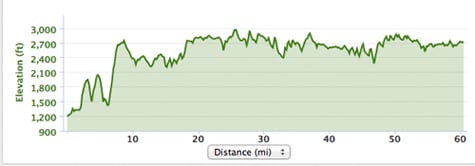Navy Chief Petty Officer Tom McNulty reviewed Garmin's Fenix ABC GPS watch back in March. He loved it. I wanted one.
I'd been eagerly waiting for an excuse to replace my tired but trusty Garmin Forerunner 310XT, and the Fenix -- with its promised long battery life -- seemed like the perfect fit.
It's a nice-looking piece of hardware with features I wanted: elevation graphs, temperature readouts and, most importantly, a variable cycle rate for the GPS.
The cycle rate setting changes how frequently the watch communicates with the satellites. The more it hits the satellites, the faster you burn through your battery. The Fenix gives you two modes to start with: Normal mode (once per second) and UltraTrac (once per 15 seconds, once per 20 seconds and once per minute). And even better, you can change the cycle rate on the fly, right on the watch. This feature solidified my decision to buy the Fenix over Suunto's comparable Ambit.
The Fenix seemed like the perfect ultrarunner watch. I wanted to love it, but it doesn't seem to want to love me.
In Normal mode, the watch works like any other, though it does take significantly longer to sync with satellites than any other GPS watch I've tried. I've found it will never (EVER) sync while I'm moving, even just walking around or getting ready before a long run (hello, red flag). I've found I have to take the thing off and set it down so it can sync in peace. But once it's locked on, the tracking is consistent and the distance and pace readouts all seem reliable.
It's when you switch to UltraTrac that things go downhill.
Garmin recommends using UltraTrac for activities lasting longer than 8 hours. The fine print from Garmin:
"Setting the update rate to 15 seconds will provide approximately 20 hours of tracking, while setting it the update rate to 20 seconds should provide greater than 24 hours of tracking time. Results will vary based on tracking conditions (heavy tree cover and other things like terrain and buildings can decrease the battery life faster)."
My first run in UltraTrac was an April 50-miler.I am not an eight-hour 50-mile runner, so the morning of the race, I navigated through the maze of menu options (press orange button --> select setup --> select system --> select GPS mode --> select UltraTrac) to switch to UltraTrac, then through a second menu maze (press orange button --> select setup --> select tracks --> select interval --> adjust time --> select done) to change the interval setting to once per 15 seconds.
You have to key in your selected interval; there isn't a list to choose from. Know that there are only three choices, though you can punch in whatever interval you want.
My watch finally found the satellites, the race gun fired, and off we went for a day in the woods.
These are woods I train in on most weekends. They are not remote, not dense. I've never had a watch -- any brand -- lose a signal in these woods.
Things were going swimmingly until about 2 hours in. I glanced down at my watch: 13 miles. I ran 20 minutes more: 13 miles. I ran 25 minutes more: 13 miles. The timer was counting up, but the distance and average pace numbers weren't changing.
Huh.
I hadn't gotten a 'lost signal' beep, but I clicked through the screens to verify that the Fenix was still locked on. It was. For good measure I paused and resumed the track. No change. More miles went by and according to my watch I was standing at mile 13.
This was my spring goal race, and I didn't have time to stand around and push buttons, so I ran and pushed buttons.
I hit the lap button. I hit the Waypoint button. Finally the watch froze, which I guess was an improvement, since it was doing something.
When I got to actual mile 17 the Fenix finally woke up and announced I'd done a half-a-mile in 53 minutes. No, Fenix, no.
But at least it was working again. We ran along until this whole process repeated itself at mile 24: Nothing-nothing-nothing-then a 38-minute three-quarters of a mile.
By this point, I was pretty annoyed. I turned the satellites off and tried to start from scratch. But this watch doesn't like to lock onto satellites while I'm walking down a city street, let alone running in the woods. After 40 minutes of searching space, I gave up on the Fenix and turned it off. By this point, it was a $400 wristwatch.
At least I knew what time it was.
I returned this Fenix the first chance I could and got a replacement Fenix. ("Huh," said the REI employee. "That's weird.")
I ran with Fenix 2.0 in UltraTrac every chance I could to see if it would cause any issues. The first run was an 18-miler in the Massanutten Mountains. By mile 4.5 (on seven other watches in my group) I was at 7.5. The miles on Fenix 2.0 continued to fly by at record pace, even though at this point I was actually, literally, standing still.
I gave up and ran the rest of the run in Normal mode.
Fenix 2.0's undoing was at my summer goal race: The Laurel Highlands 70-miler in June.
This watch made it 9.5 miles, and then repeated the original Fenix's song and dance: Freeze for hours, then report a 3-hour mile.
I decided to let the watch keep running, even though it had clearly given up on tracking. At least I knew my total time. I had it in once-per-15 second mode, which should have given me about 20 hours of battery. 16 hours in it gave me a low battery alert and was already down to 20 percent. I changed the interval to once-per-20 seconds which should have extended the battery enough for me to finish.
It didn't.
When I crossed the line in just over 18 hours the battery was dead, thereby eating all my data.
So what am I doing wrong? I asked a friend, who was also running Laurel with his Fenix, if his watch had behaved.
"No, mine worked perfectly," he wrote back. "Out of the first roughly 47 miles, it calculated I ran 38.7 miles with elevation gain of 36 feet and elevation loss of 30 feet. Looked pretty accurate to me since the beginning was so flat. I'm thinking I'm taking it back to my friendly REI."
Maybe you can't hear his sarcasm. Here's the elevation graph from a friend's 310XT.

So two goal races down, two Fenix failures. What's going on?
I emailed Garmin. After a lengthy back-and-forth in email, the rep told me this:
"Unfortuntely with the type of racing you are doing the Ultra-Trac option is not going to work for you." he wrote. "You are not doing anything wrong that I can think of it is just a limitation of the Ultra-Trac feature."
He went on to explain:
"When you set the refresh rate to ten seconds using the UltraTrac option the device has to acquire satellites all over again which would explain the gaps you are experiencing. The UltraTrac option really is not the first option I would use for running events. It is more for use in a hiking situation."
So it's my understanding that UltraTrac doesn't work -- or doesn't work well -- because the Fenix can't find the satellites while you're moving. Not really ideal when you're a runner, or someone who moves.
To me, this makes the UltraTrac feature basically useless.
So now what I have is a $400 watch that can only be used reliably in Normal mode, which shortens the battery life to 8-12 hours. Unless you really, really want some of the features exclusive to the Fenix, I feel you'd be better off with a Forerunner 910XT or the significantly cheaper 310XT. Both have up to 20 hours of battery life with a once-per-second GPS cycle rate.
Or you could just get the new Ambit. We're trying to get our hands on one, if we do, stay tuned for a review.
Sara Davidson is an ultrarunner and our resident women's gear destroyer. Even though she doesn't have a GPS track from the race, she swears she's a Laurel Highlands finisher.




